Monitoring of Spirulina Flakes and Powders from Italian Companies
Abstract
:1. Introduction
2. Results and Discussion
2.1. Commercial Product Selection
2.2. Macro-Microscopical and Olfactory Evaluation
2.3. Chemical Analyses
2.3.1. Carotenoids, Chlorophylls and Pheophytins
2.3.2. Phycobiliproteins
2.3.3. Phenolic Compounds
2.3.4. Proteins
2.3.5. Discrimination of the Samples
3. Materials and Methods
3.1. Materials
3.2. Macro- and Microscopic Characterization
3.3. Preparation of Spirulina Extracts
3.4. Analysis of Carotenoids
3.5. Analysis of Chlorophylls and Pheophytins
3.6. Analysis of Phycobiliproteins
3.7. Analysis of Phenols
3.8. Protein Content
3.9. Statistical Analysis
4. Conclusions
Author Contributions
Funding
Institutional Review Board Statement
Informed Consent Statement
Data Availability Statement
Acknowledgments
Conflicts of Interest
Sample Availability
References
- Grosshagauer, S.; Kraemer, K.; Somoza, V. The True Value of Spirulina. J. Agric. Food Chem. 2020, 68, 4109–4115. [Google Scholar] [CrossRef] [PubMed]
- de la Jara, A.; Ruano-Rodriguez, C.; Polifrone, M.; Assunçao, P.; Brito-Casillas, Y.; Wägner, A.M.; Serra-Majem, L. Impact of dietary Arthrospira (Spirulina) biomass consumption on human health: Main health targets and systematic review. J. Appl. Phycol. 2018, 30, 2403–2423. [Google Scholar] [CrossRef]
- Vonshak, A. Spirulina platensis (Arthrospira): Physiology, Cell-Biology and Biotechnology; Taylor & Francis: London, UK, 2002. [Google Scholar]
- Tomaselli, L.; Palandri, M.R.; Tredici, M.R. On the correct use of the Spirulina designation Algol. Stud. Arch. Für Hydrobiol. 1996, 48, 539–548. [Google Scholar] [CrossRef]
- Hongsthong, A.; Sirijuntarut, M.; Prommeenate, P.; Thammathorn, S.; Bunnag, B.; Cheevadhanarak, S.; Tanticharoen, M. Revealing differentially expressed proteins in two morphological forms of Spirulina platensis by proteomic analysis. Mol. Biotechnol. 2007, 36, 123–130. [Google Scholar] [CrossRef] [PubMed]
- Yadav, A.; Monsieurs, P.; Misztak, A.; Waleron, K.; Leys, N.; Cuypers, A.; Janssen, P.J. Helical and linear morphotypes of Arthrospira sp. PCC 8005 display genomic differences and respond differently to 60Co gamma irradiation. Eur. J. Phycol. 2019, 55, 129–146. [Google Scholar] [CrossRef]
- Chacón-Lee, T.L.; González-Mariño, G.E. Microalgae for healthy foods—Possibilities and challenges. Compr. Rev. Food Sci. Food Saf. 2010, 6, 655–675. [Google Scholar] [CrossRef] [PubMed]
- Colla, L.M.; Bertolin, T.E.; Costa, J.A. Fatty Acids Profile of Spirulina platensis Grown under Different Temperatures and Nitrogen Concentrations. Z. Naturforsch C. J. Biosci. 2004, 59, 55–59. [Google Scholar] [CrossRef]
- Niccolai, A.; Shannon, E.; Abu-Ghannam, N.; Biondi, N.; Rodolfi, L.; Tredici, M.R. Lactic Acid Fermentation of Arthrospira platensis (Spirulina) Biomass for Probiotic-Based Products. J. Appl. Phycol. 2019, 31, 1077–1083. [Google Scholar] [CrossRef] [Green Version]
- Remirez, D.; González, R.; Merino, N.; Rodriguez, S.; Ancheta, O. Inhibitory Effects of Spirulina in Zymosan-Induced Arthritis in Mice. Mediat. Inflamm. 2002, 11, 75–79. [Google Scholar] [CrossRef] [Green Version]
- Kulshreshtha, A.; Zacharia, A.J.; Jarouliya, U.; Bhadauriya, P.; Prasad, G.B.; Bisen, P.S. Spirulina in Health Care Management. Curr. Pharm. Biotechnol. 2008, 9, 400–405. [Google Scholar] [CrossRef] [Green Version]
- Mallikarjun Gouda, K.G.; Kavitha, M.D.; Sarada, R. Antihyperglycemic, Antioxidant and Antimicrobial Activities of the Butanol Extract from Spirulina platensis. J. Food Biochem. 2015, 39, 594–602. [Google Scholar] [CrossRef]
- Wu, Q.; Liu, L.; Miron, A.; Klímová, B.; Wan, D.; Kuča, K. The Antioxidant, Immunomodulatory, and Anti-inflammatory Activities of Spirulina: An Overview. Arch. Toxicol. 2016, 90, 1817–1840. [Google Scholar] [CrossRef] [PubMed]
- Finamore, A.; Palmery, M.; Bensehaila, S.; Peluso, I. Antioxidant, Immunomodulating, and Microbial-Modulating Activities of the Sustainable and Ecofriendly Spirulina. Oxid. Med. Cel Longev. 2017, 2017, 3247528. [Google Scholar] [CrossRef] [Green Version]
- Strömberg, I.; Gemma, C.; Vila, J.; Bickford, P.C. Blueberry- and Spirulina-Enriched Diets Enhance Striatal Dopamine Recovery and Induce a Rapid, Transient Microglia Activation after Injury of the Rat Nigrostriatal Dopamine System. Exp. Neurol. 2005, 196, 298–307. [Google Scholar] [CrossRef]
- Chen, J.C.; Liu, K.S.; Yang, T.J.; Hwang, J.H.; Chan, Y.C.; Lee, I.T. Spirulina and C-Phycocyanin Reduce Cytotoxicity and Inflammation-Related Genes Expression of Microglial Cells. Nutr. Neurosci. 2012, 15, 252–256. [Google Scholar] [CrossRef]
- Pabon, M.M.; Jernberg, J.N.; Morganti, J.; Contreras, J.; Hudson, C.E.; Klein, R.L.; Bickford, P.C. A Spirulina-Enhanced Diet Provides Neuroprotection in an α-synuclein Model of Parkinson’s Disease. PLoS ONE 2012, 7, e45256. [Google Scholar] [CrossRef] [Green Version]
- Lima, F.A.V.; Joventino, I.P.; Joventino, F.P.; de Almeida, A.C.; Neves, K.R.T.; do Carmo, M.R.; Leal, L.K.A.M.; de Andrade, G.M.; de Barros Viana, G.S. Neuroprotective Activities of Spirulina platensis in the 6-OHDA Model of Parkinson’s Disease Are Related to its Anti-inflammatory Effects. Neurochem. Res. 2017, 42, 3390–3400. [Google Scholar] [CrossRef]
- Haider, S.; Shahzad, S.; Batool, Z.; Sadir, S.; Liaquat, L.; Tabassum, S.; Perveen, T. Spirulina platensis Reduces the Schizophrenic-like Symptoms in Rat Model by Restoring Altered APO-E and RTN-4 Protein Expression in Prefrontal Cortex. Life Sci. 2021, 277, 119417. [Google Scholar] [CrossRef]
- Bhat, V.B.; Madyastha, K.M. C-Phycocyanin: A potent peroxyl radical scavenger in vivo and in vitro. Biochem. Biophys. Res. Commun. 2000, 275, 20–25. [Google Scholar] [CrossRef]
- Piñero Estrada, J.E.; Bermejo Bescós, P.; Villar del Fresno, A.M. Antioxidant activity of different fractions of Spirulina platensis protean extract. Il Farmaco. 2001, 56, 497–500. [Google Scholar] [CrossRef]
- Mendiola, J.A.; Jaime, L.; Santoyo, S.; Regleroa, G.; Cifuentes, A.; Ibañezb, E.; Señoráns, F.J. Screening of functional compounds in supercritical fluid extracts from Spirulina platensis. Food Chem. 2007, 102, 1357–1367. [Google Scholar] [CrossRef]
- Piovan, A.; Battaglia, J.; Filippini, R.; Dalla Costa, V.; Facci, L.; Argentini, C.; Pagetta, A.; Giusti, P.; Zusso, M. Pre- and Early Post-treatment With Arthrospira platensis (Spirulina) Extract Impedes Lipopolysaccharide-triggered Neuroinflammation in Microglia. Front. Pharmacol 2021, 12, 724993. [Google Scholar] [CrossRef] [PubMed]
- Mulders, J.M.K.; Lamers, P.P.; Martens, D.E.; Wijffels, R.H. Phototrophic pigment production with microalgae: Biological constraints and opportunities. J. Phycol. 2014, 50, 229–242. [Google Scholar] [CrossRef] [PubMed]
- Kamble, S.P.; Gaikar, R.B.; Padalia, R.B.; Shinde, K.D. Extraction and purification of C-phycocyanin from dry Spirulina powder and evaluating its antioxidant, anticoagulation and prevention of DNA damage activity. J. Appl. Pharm. Sci. 2013, 3, 149–153. [Google Scholar] [CrossRef]
- Nagaoka, S.; Shimizu, K.; Kaneko, H.; Shibayama, F.; Morikawa, K.; Kanamaru, Y.; Otsuka, A.; Hirahashi, T.; Kato, T.A. Novel protein C-phycocyanin plays a crucial role in the hypocholesterolemic action of Spirulina platensis concentrate in rats. J. Nutr. 2005, 135, 2425–2430. [Google Scholar] [CrossRef] [Green Version]
- Ramos-Romero, S.; Torrella, J.R.; Pagès, T.; Viscor, G.; Torres, J.L. Edible Microalgae and Their Bioactive Compounds in the Prevention and Treatment of Metabolic Alterations. Nutrients 2021, 13, 563. [Google Scholar] [CrossRef] [PubMed]
- Andrade, L.M.; Andrade, C.J.; Dias, N.; Nascimento, C.A.O.; Mendes, M.A. Chlorella and Spirulina Microalgae as Sources of Functional Foods, Nutraceuticals, and Food Supplements; an Overview. MOJ FPT. 2018, 6, 00144. [Google Scholar] [CrossRef] [Green Version]
- Seghiri, R.; Kharbach, M.; Essamri, A. Functional Composition, Nutritional Properties, and Biological Activities of Moroccan Spirulina Microalga. J. Food Qual. 2019, 2019, 3707219. [Google Scholar] [CrossRef] [Green Version]
- Aouir, A.; Amiali, M.; Bitam, A.; Benchabane, A.; Raghavan, V.G. Comparison of the biochemical composition of different Arthrospira platensis strains from Algeria, Chad and the USA. Food Measure. 2017, 11, 913–923. [Google Scholar] [CrossRef]
- Soni, R.A.; Sudhakar, K.; Rana, R.S. Spirulina—From growth to nutritional product: A review. Trends Food Sci. Technol. 2017, 69, 157–171. [Google Scholar] [CrossRef] [Green Version]
- Papalia, T.; Sidari, R.; Panuccio, M.R. Impact of Di_erent Storage Methods on Bioactive Compounds in Arthrospira platensis Biomass. Molecules 2019, 24, 2810. [Google Scholar] [CrossRef] [PubMed] [Green Version]
- Nouri, E.; Abbasi, H. Effects of Different Processing Methods on Phytochemical Compounds and Antioxidant Activity of Spirulina platensis. Appl. Food Biotechnol. 2018, 5, 221–232. [Google Scholar] [CrossRef]
- Desmorieux, H.; Hernandez, F. Biochemical adn physical criteria of spirulina after different drying processes. In Proceedings of the 14th International Drying Symposium, São Paulo, Brazil, 22–25 August 2004. [Google Scholar]
- Park, W.S.; Kim, H.-J.; Li, M.; Lim, D.-H.; Kim, J.; Kwak, S.-S.; Kang, C.-M.; Ferruzzi, M.G.; Ahn, M.-J. Two Classes of Pigments, Carotenoids and C-Phycocyanin, in Spirulina Powder and Their Antioxidant Activities. Molecules 2018, 23, 2065. [Google Scholar] [CrossRef] [PubMed] [Green Version]
- Hynstova, V.; Sterbova, D.; Klejdus, B.; Hedbavny, J.; Huska, D.; Adam, V. Separation, identification and quantification of carotenoids and chlorophylls in dietary supplements containing Chlorella vulgaris and Spirulina platensis using High Performance Thin Layer Chromatography. J. Pharm. Biomed. Anal. 2018, 148, 108–118. [Google Scholar] [CrossRef] [PubMed]
- Torres-Tiji, Y.; Fields, F.J.; Mayfield, S.P. Microalgae as future food source. Biotechnol. Adv. 2020, 41, 107536. [Google Scholar] [CrossRef]
- Shabana, K.A.; Arabi, M.S. Spirulina: An overview. Int. J. Pharm. Pharm. Sci. 2012, 4, 9–15. [Google Scholar]
- Wang, Z.P.; Zhao, Y. Morphological reversion of Spirulina (Arthrospira) platensis (Cyanophyta): From Linear to Helical. J. Phycol. 2005, 41, 622–628. [Google Scholar] [CrossRef]
- Chaiyasitdhi, A.; Miphonpanyatawichok, W.; Riehle, M.O.; Phatthanakun, R.; Surareungchai, W.; Kundhikanjana, W. The biomechanical role of overall-shape transformation in a primitive multicellular organism: A case study of dimorphism in the filamentous cyanobacterium Arthrospira platensis. PLoS ONE 2018, 13, e0196383. [Google Scholar] [CrossRef] [Green Version]
- Lu, W.; Maidannyk, V.A.; Lim, A.S.L. Carotenoids degradation and precautions during processing. In Carotenoids: Properties, Processing and Applications, 1st ed.; Galanakis, C., Ed.; Elsevier: Melbourne, Australia, 2020. [Google Scholar] [CrossRef]
- Hsu, C.Y.; Chao, P.Y.; Hu, S.P.; Yang, C.M. The Antioxidant and Free Radical Scavenging Activities of Chlorophylls and Pheophytins. Food Sci. Nutr. 2013, 4, 8A. [Google Scholar] [CrossRef] [Green Version]
- Boussiba, S.; Richmond, A.E. C-Phycocyanin as a Storage Protein in the Blue-Green Alga Spirulina platensis. Arch. Microbiol. 1980, 125, 143–147. [Google Scholar] [CrossRef]
- Rizzo, R.F.; Santos, B.N.C.; Castro, G.F.P.S.; Passos, T.S.; Nascimento, M.A.; Guerra, H.D.; da Silva, C.G.; Dias, D.; Domingues, J.R.; de Lima-Araujo, K.G. Productions of phycobiliproteins by Arthrospira platensis under different light conditions for applications in food products. Food Sci. Tech. 2015, 35, 247–252. [Google Scholar] [CrossRef] [Green Version]
- Kepekçi, R.A.; Polat, S.; Çelik, A.; Bayat, N.; Saygideger, S.D. Protective effect of Spirulina platensis enriched in phenolic compounds against hepatotoxicity induced by CCl4. Food Chem. 2013, 141, 1972–1979. [Google Scholar] [CrossRef] [PubMed]
- Abd El-Baky, H.H.; El Baz, F.K.; El-Baroty, G.S. Production of phenolic compounds from Spirulina maxima microalgae and its protective effects. Afr. J. Biotechnol. 2009, 8, 7059–7067. [Google Scholar] [CrossRef]
- Ouaabou, R.; Nabil, B.; Ouhammou, M.; Idlimam, A.; Lamharrar, A.; Ennahli, S.; Hanine, H.; Mahrouz, M. Impact of solar drying process on drying kinetics, and on bioactive profile of Moroccan sweet cherry. Renew. Energy. 2020, 151, 908–918. [Google Scholar] [CrossRef]
- Dillon, J.C.; Phan, P.A. Spirulina as a source of proteins in human nutrition. Bull. Inst. Océano Monaco 1993, 12, 103–107. [Google Scholar]
- Fleurence, J. Seaweed Proteins: Biochemical, Nutritional Aspects and Potential Uses. Trends Food Sci. Technol. 1999, 10, 25–28. [Google Scholar] [CrossRef]
- Liestianty, D.; Rodianawati, I.; Arfah, R.A.; Asma, A.; Patimah; Sundari; Muliadi. Nutritional analysis of spirulina sp to promote as superfood candidate. IOP Conf. Ser.: Mater. Sci. Eng. 2019, 509, 012031. [Google Scholar] [CrossRef]
- Fleurence, J.; Le Coeur, C.; Mabeau, S.; Maurice, M.; Landrein, A. Comparison of different extractive procedures for proteins from the edible seaweeds Ulva rigida and Ulva rotundata. J. Appl. Phycol. 1995, 7, 577–582. [Google Scholar] [CrossRef]
- Jones, D.B. Factors for Converting Percentages of Nitrogen in Foods and Feeds into Percentages of Proteins; US Department of Agriculture: Washington, DC, USA, 1941; pp. 1–22.
- Angell, A.R.; Mata, L.; de Nys, R.; Paul, N.A. The protein content of seaweeds: A universal nitrogen-to-protein conversion factor of five. J. Appl. Phycol. 2016, 28, 511–524. [Google Scholar] [CrossRef]
- Lichtenthaler, H.K. Chlorophylls and Carotenoids: Pigments of Photosynthetic Biomembranes. Method. Enzymol. 1987, 148, 350–382. [Google Scholar] [CrossRef]
- Li, H.B.; Cheng, K.W.; Wong, C.C.; Fan, K.X.; Chen, F.; Jiang, Y. Evaluation of antioxidant capacity and total phenolic content of different fractions of selected microalgae. Food chem. 2007, 102, 771–776. [Google Scholar] [CrossRef]
- Heidelbaugh, N.D.; Huber, C.S.; Bednarczyk, J.F.; Smith, M.C.; Rambaut, P.C.; Wheeler, H.O. Comparison of three methods for calculating protein content of foods. J. Agric. Food Chem. 1975, 23, 611–613. [Google Scholar] [CrossRef] [PubMed]
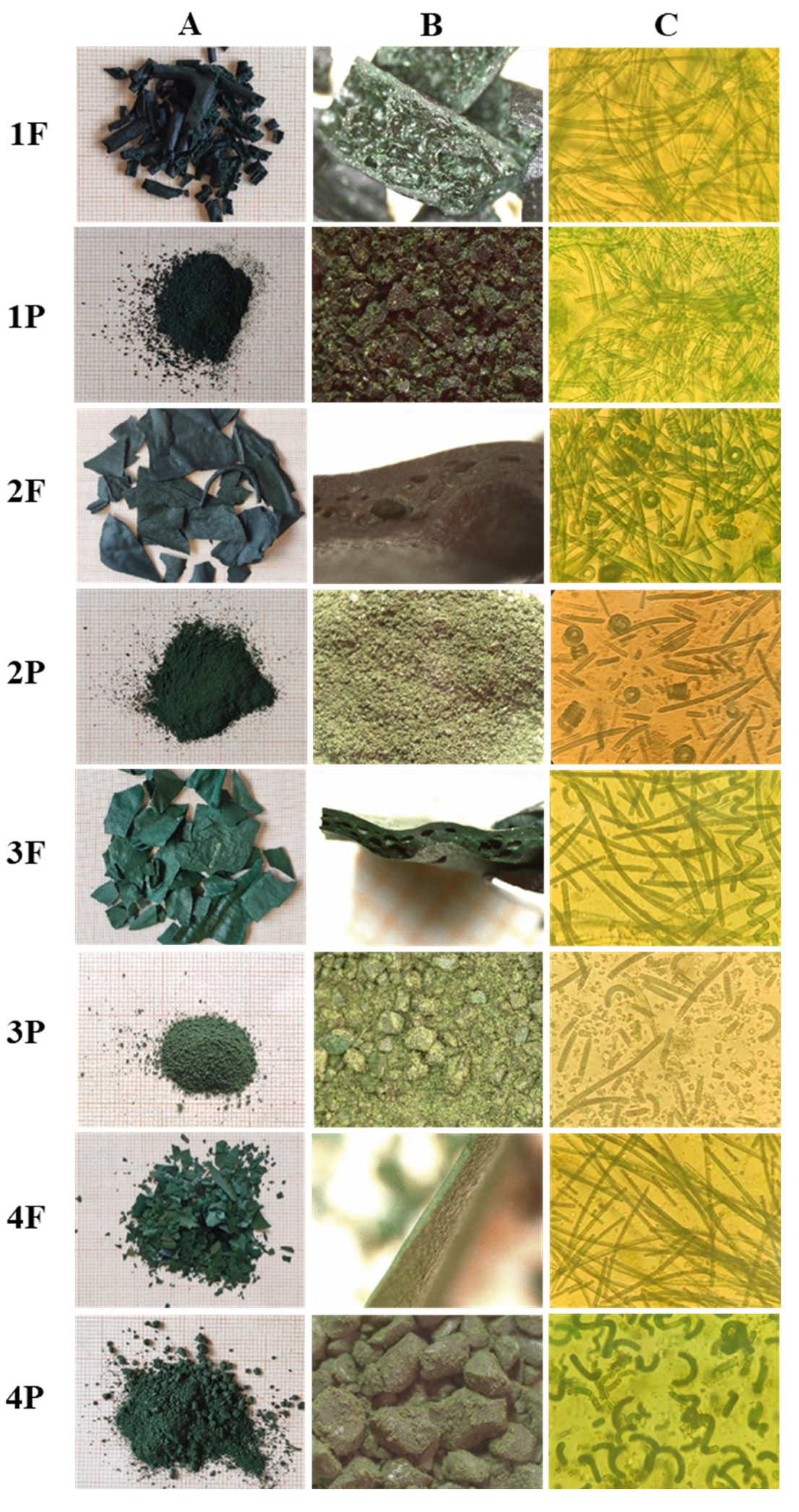

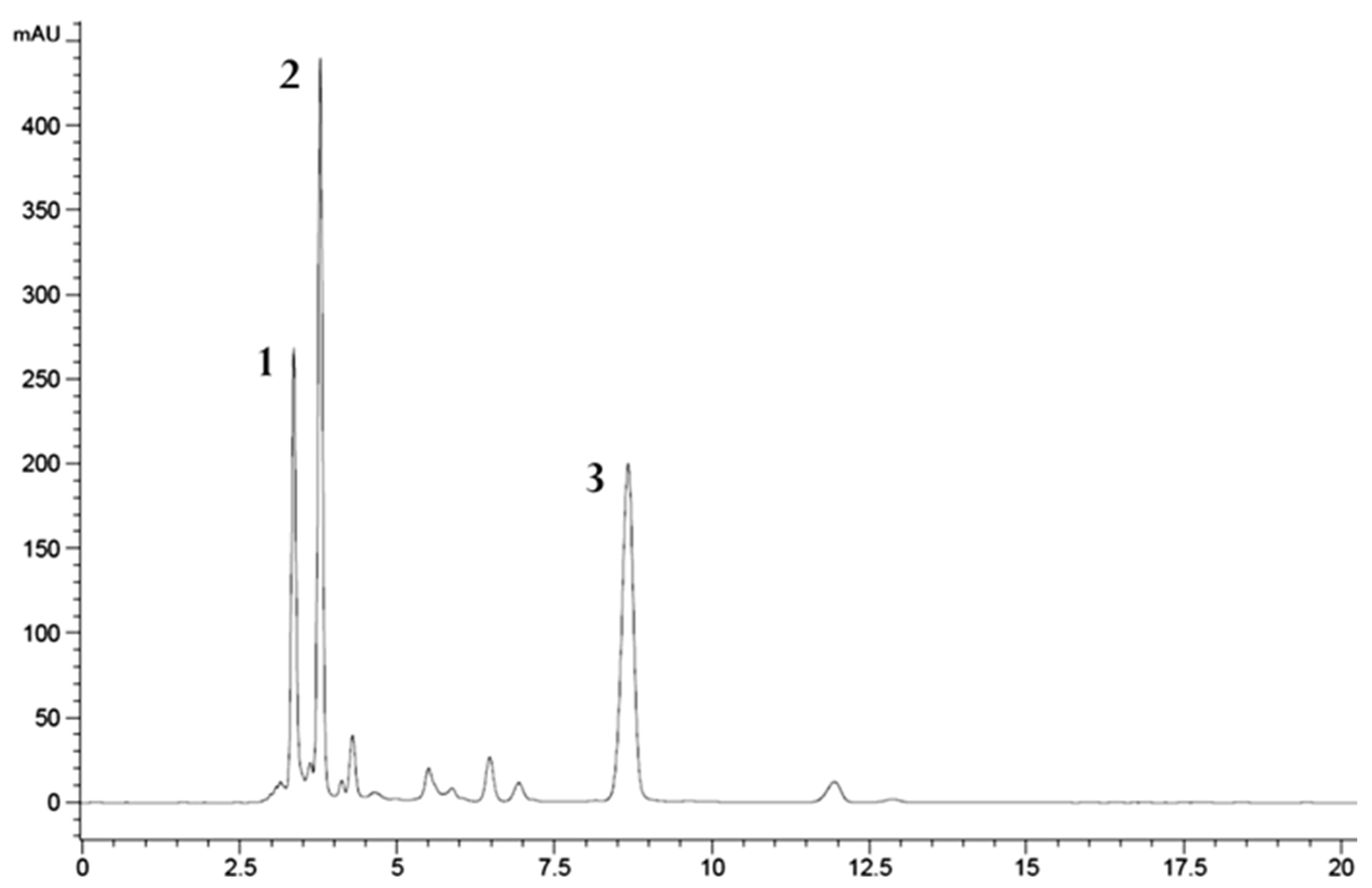
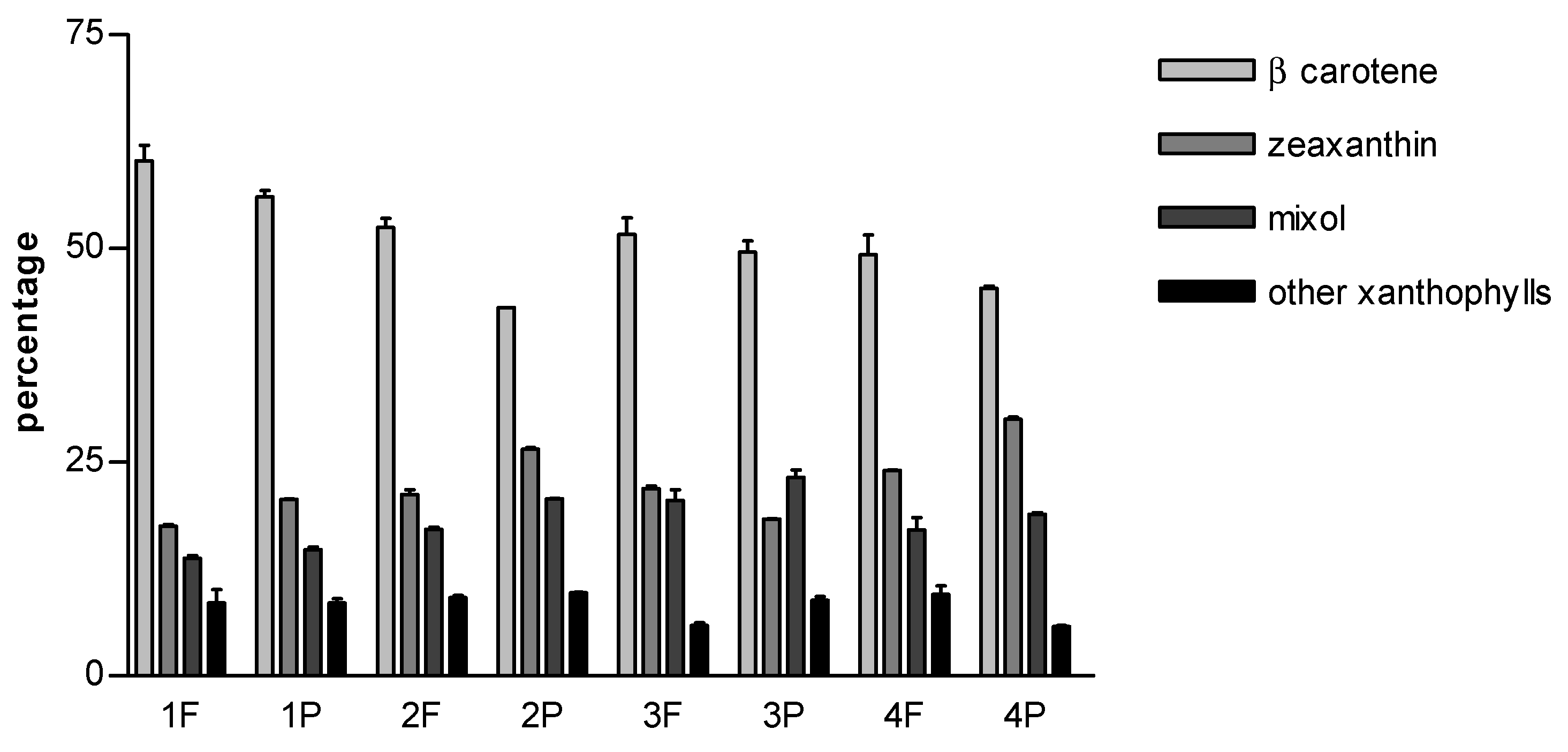
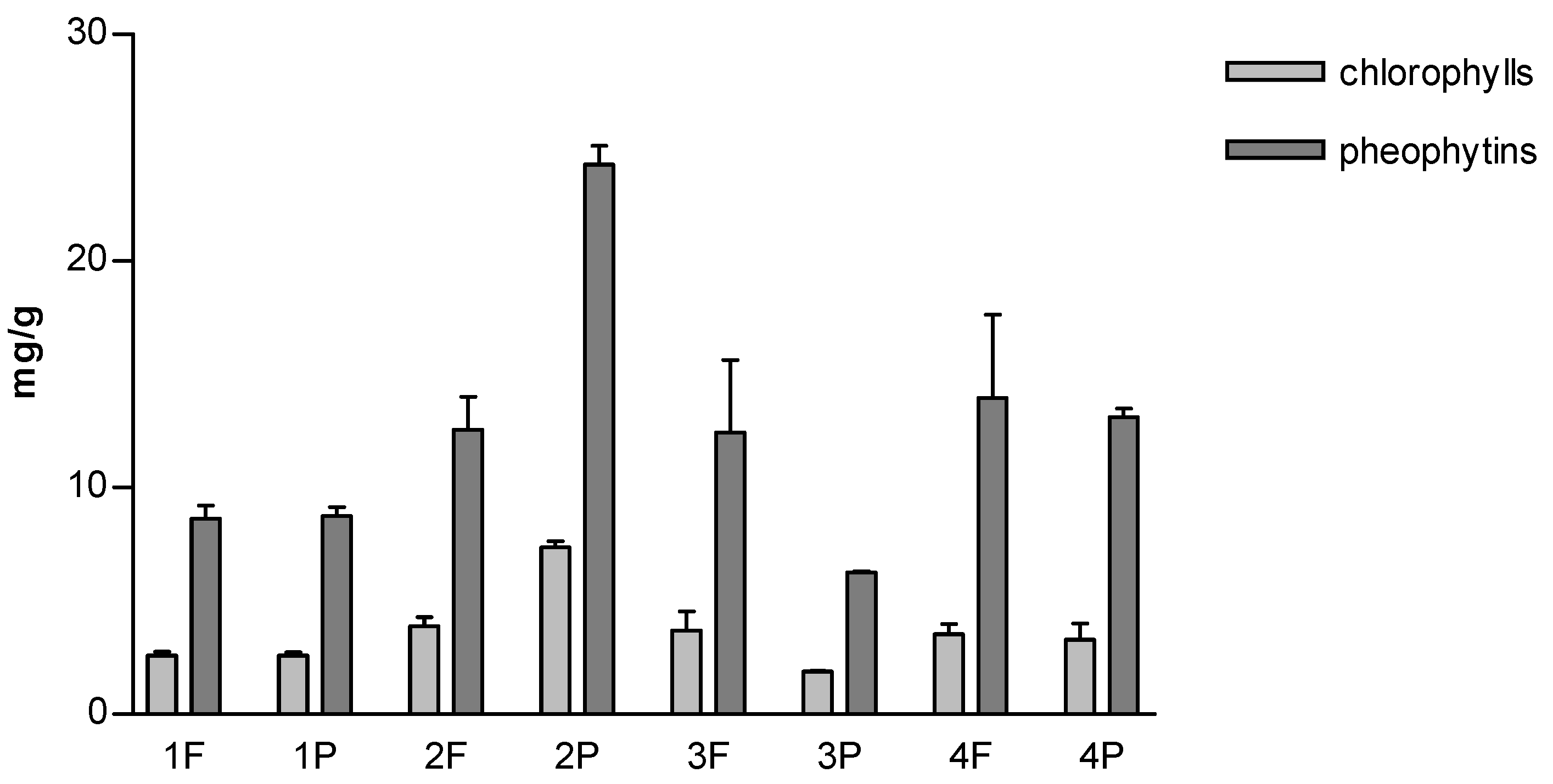

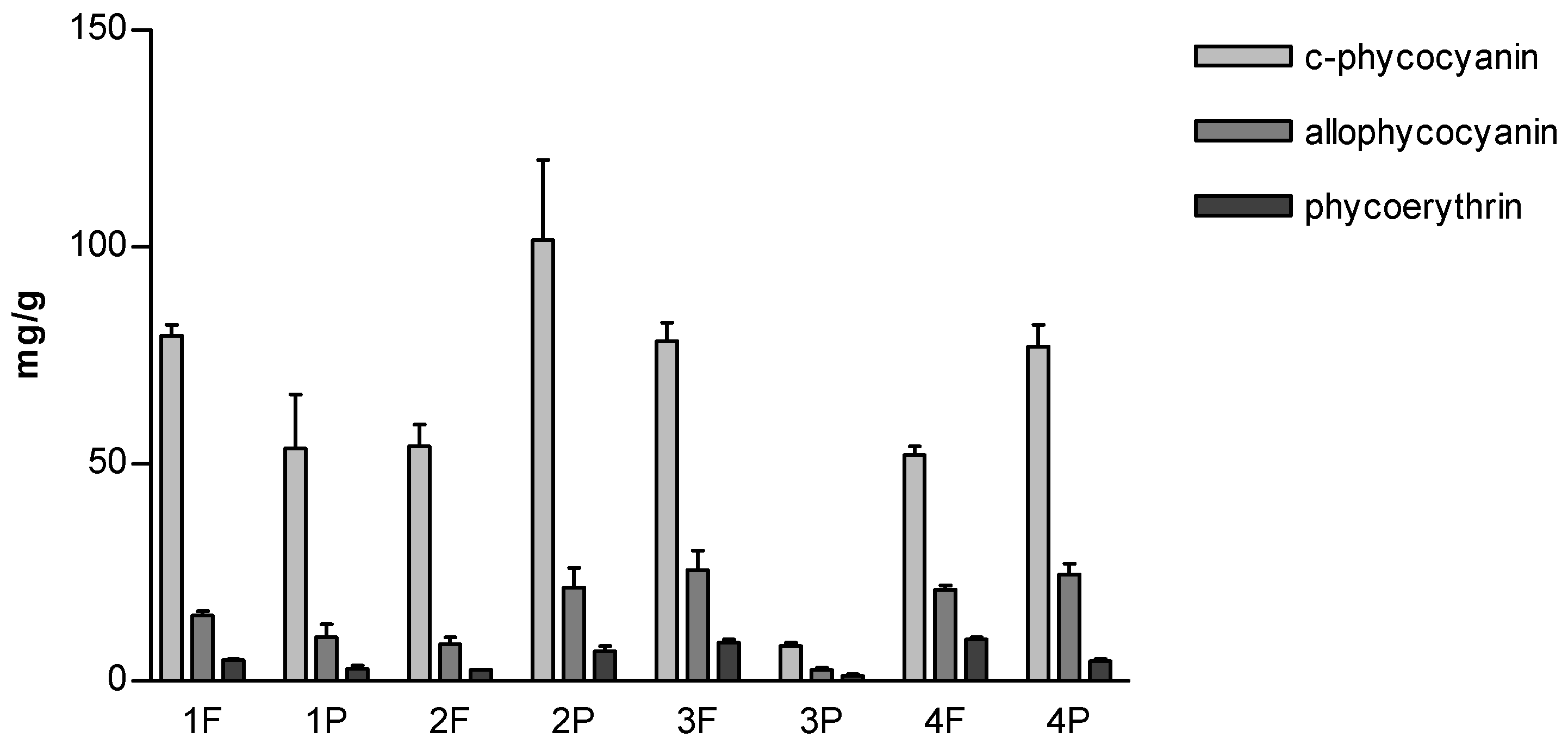

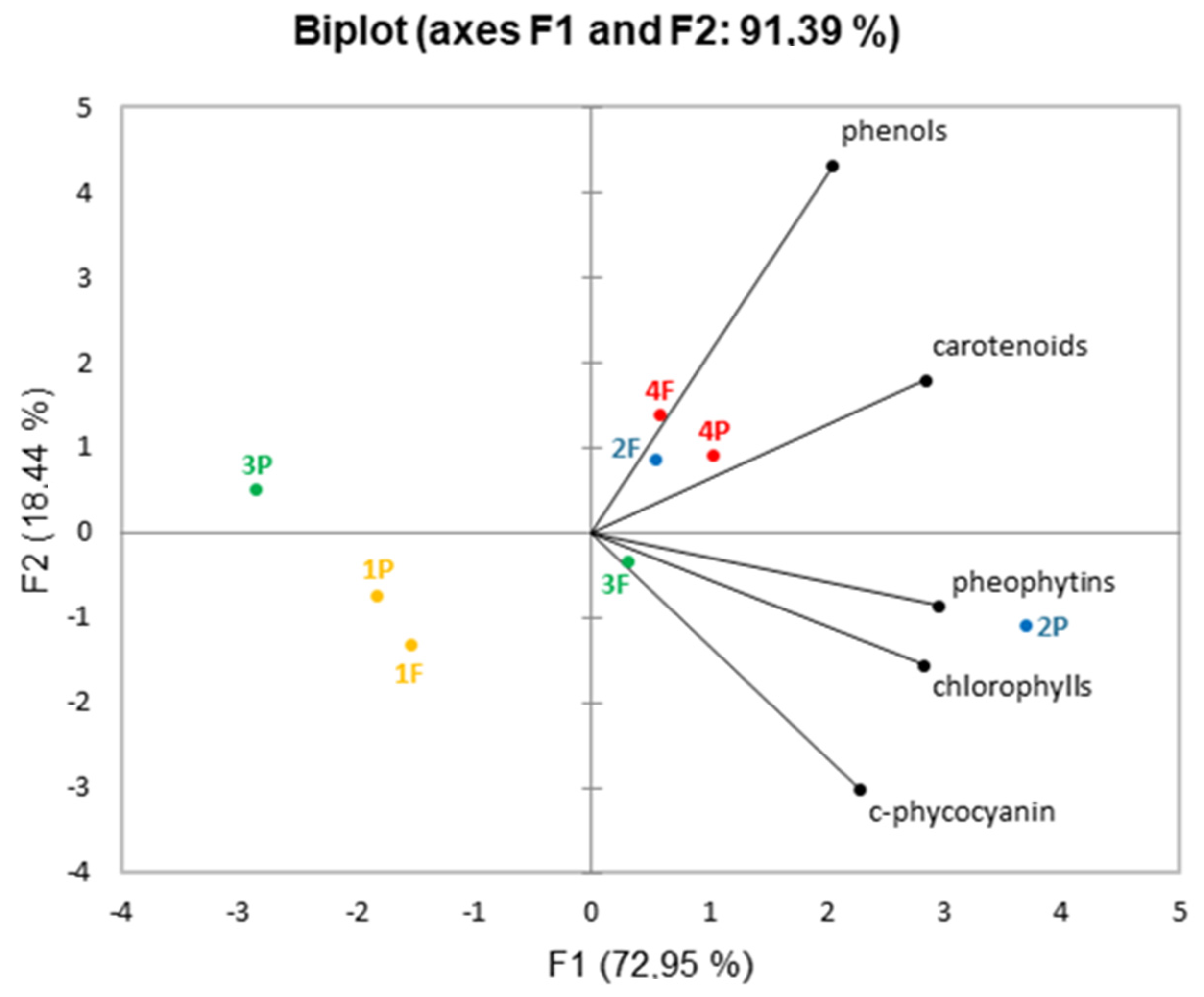
| Samples | 1F | 1P | 2F | 2P | 3F | 3P | 4F | 4P |
|---|---|---|---|---|---|---|---|---|
| Carotenoids | 0.24 ± 0.01 | 0.32 ± 0.02 | 1.28 ± 0.18 | 1.63 ± 0.08 | 1.04 ± 0.35 | 0.37 ± 0.00 | 1.01 ± 0.30 | 1.41 ± 0.08 |
| Samples | 1F | 1P | 2F | 2P | 3F | 3P | 4F | 4P |
|---|---|---|---|---|---|---|---|---|
| Chlorophylls/Pheophytins | 0.30 | 0.30 | 0.31 | 0.30 | 0.30 | 0.30 | 0.25 | 0.25 |
| Samples | 1F | 1P | 2F | 2P | 3F | 3P | 4F | 4P |
|---|---|---|---|---|---|---|---|---|
| Phenols | 1.27 ± 0.06 | 1.30 ± 0.03 | 3.04 ± 0.01 | 2.67 ± 0.02 | 2.26 ± 0.16 | 1.47 ± 0.03 | 3.84 ± 0.11 | 3.48 ± 0.13 |
| Samples | 1F | 1P | 2F | 2P | 3F | 3P | 4F | 4P |
|---|---|---|---|---|---|---|---|---|
| Proteins | 54.38 | 60.56 | 59.94 | 60.06 | 54.94 | 58.00 | 60.56 | 56.13 |
| TRICHOMES %Straight %Helical | CAROTENOIDS | CHLOROPHYLLS | PHEOPHYTINS | PHYCOBILIPROTEINS | PHENOLS | ||
|---|---|---|---|---|---|---|---|
| 1F | 100 | 0 | 1 | 1.4× | 1.4× | 8.4× | 1 |
| 1P | 100 | 0 | 1.4× | 1.4× | 1.4× | 5.6× | 1 |
| 2F | 60 | 40 | 5.3× | 2.0× | 2.0× | 5.5× | 2.4× |
| 2P | 60 | 40 | 6.8× | 3.9× | 3.9× | 11.0× | 2.1× |
| 3F | 90 | 10 | 4.3× | 1.9× | 2.0× | 9.6× | 1.8× |
| 3P | 90f | 10f | 1.5× | 1 | 1 | 1 | 1.2× |
| 4F | 100 | 0 | 4.2× | 1.9× | 2.2× | 7.0× | 3.0× |
| 4P | 10 | 90 | 5.9× | 1.7× | 2.0× | 9.0× | 2.7× |
Publisher’s Note: MDPI stays neutral with regard to jurisdictional claims in published maps and institutional affiliations. |
© 2022 by the authors. Licensee MDPI, Basel, Switzerland. This article is an open access article distributed under the terms and conditions of the Creative Commons Attribution (CC BY) license (https://creativecommons.org/licenses/by/4.0/).
Share and Cite
Dalla Costa, V.; Filippini, R.; Zusso, M.; Caniato, R.; Piovan, A. Monitoring of Spirulina Flakes and Powders from Italian Companies. Molecules 2022, 27, 3155. https://doi.org/10.3390/molecules27103155
Dalla Costa V, Filippini R, Zusso M, Caniato R, Piovan A. Monitoring of Spirulina Flakes and Powders from Italian Companies. Molecules. 2022; 27(10):3155. https://doi.org/10.3390/molecules27103155
Chicago/Turabian StyleDalla Costa, Vanessa, Raffaella Filippini, Morena Zusso, Rosy Caniato, and Anna Piovan. 2022. "Monitoring of Spirulina Flakes and Powders from Italian Companies" Molecules 27, no. 10: 3155. https://doi.org/10.3390/molecules27103155






